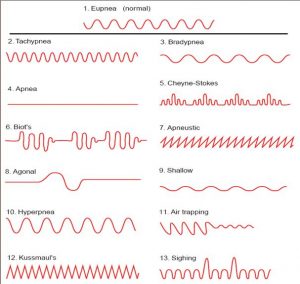Normal and Abnormal Patterns of Respiration
Respiratory Physiotherapy is an integral part of ay rehabilitation protocol. Respiratory physiotherapy is the foremost therapeutic intervention to any rehabilitation program following prolonged bed rest due to whatever cause of illness or injury or surgical intervention. A proper examination of respiration is crucial for effective respiratory therapy. Usually, four parameters of respiration are considered: rate, depth, rhythm and sound. These parameters help the respiratory physiotherapist to determine the pattern of respiration which is important to program and deliver an effective therapeutic intervention.
Patterns of respiration
Normal (Eupnea)
The rate of respiration is simply the number of breaths per minute. However, it is only the count of either inspirations or expirations per minute, but not the both. Eupnea is the normal respiratory rate and pattern of 12-20 breaths per minute for adult, 20-30 for infants and 15-22 for older population.

Rapid shallow breathing (Tachypnea)
Tachypnea is the condition of rapid and shallow breathing which is sometimes confused for hyperventilation which is a condition of rapid and deep breathing. With shallow breathing or respiration, only a small amount of air is exchanged, typically with minimal lung expansion or chest wall movement.
It can be caused by number of conditions. Chronic conditions like restrictive lung diseases, pleuritic chest pain, asthma, anxiety or obesity can lead to rapid shallow breathing. Tachypnea is the common warning sign for children pneumonia or bronchitis in adult. Also, some other acute conditions like a elevated diaphragm, shock or heat stroke, heart failure, choking, pulmonary embolism can also cause tachypnea.
Rapid deep breathing (hyperpnea, hyperventilation)
It is the condition of rapid and deep breathing which can cause imbalance of oxygen and carbondioxide levels in the body. Usually, there is rapid reduction in the level of carbondioxide which can raise the ph value of blood. This alkalinity of blood can then lead to narrowing of blood vessels and reduction in blood supply including supply to the brain. Patient can feel lightheadedness, tingling in fingers and in severe cases can lose consciousness. Common causes of hyperventilation are diabetic ketoacidosis, metabolic acidosis, heart failure, stress and anxiety, pulmonary embolism, heat strokes, pregnancy, sepsis, cystic fibrosis etc.
Kussmaul breathing is deep breathing associated with metabolic acidosis. It may be fast, normal or slow in rate.
Slow breathing (bradypnea)
Bradypnea is the condition of abnormally slow breathing rate of 10 breaths or less per minute. It is usually associated with increased intracranial pressure due to various reasons; drug induced respiratory depression or diabetic coma.
Apnea
Apnea is the serious condition when there is no respiration at all. This condition is usually transient but if sustained for longer than few minutes can cause brain damage and even death.
Cheyne-stokes breathing
This pattern of breathing is characterized by regular periods of deep breathing alternating with slow breathing and ultimately no breathing (apnea). Respiration waxes and wanes cyclically. This pattern may be normal in children or aging people during their sleep. However, it should be consulted with professionals as it could be the indication of other serious conditions. Some other possible causes of cheyne-stokes breathing pattern are heart failure, uremia, drug-induced respiratory depression, increased intra cranial pressure, and brain damage, typically involving both sides of hemispheres or diencephalon.
Ataxic breathing (Biot’s breathing)
Biot’s breathing is characterized by unpredictable irregularity in breathing pattern. Breathing may be shallow or deep, rapid or slow and even stop for brief periods. This irregularity is typically seen following brain injury most commonly at the medullary level. It is also seen when there is respiratory depression due to various reason.
Apneustic breathing
It is an abnormal respiration characterized by prolonged inspiration. It is associated with damage to upper pons.
Sighing Respiration
Occasional sighs are normal. However, frequent sighs punctuating the breathing cycle may be the warning sign of hyperventilation syndrome – a common cause of dyspnea and dizziness.
Air trapping/ prolong expiration / obstructive breathing
Common in obstructive lung diseases where there is increased airway resistance and thus expiration is difficult and prolonged. Patient unable to expire a normal volume and with the increase rate of respiration, air is trapped in the lungs. This air trapping over expands the chest and eventually breathing becomes more shallow.


